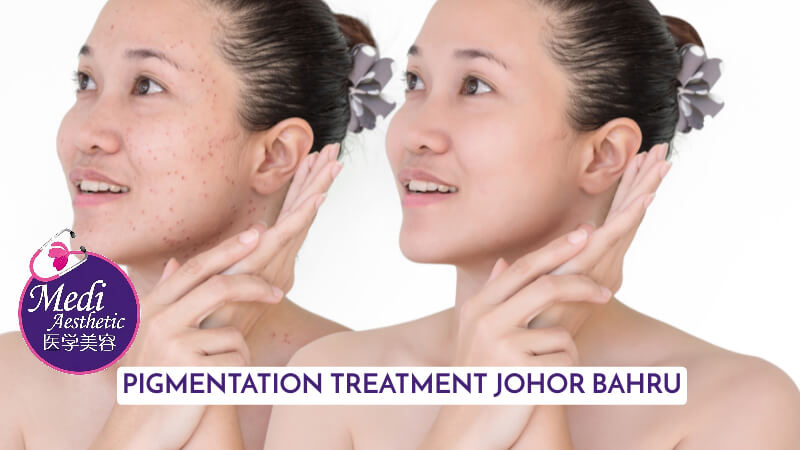Uneven pigmentation is a common skin condition that can be caused by various factors, including excessive sun exposure or hormonal changes. Treatment options for uneven pigmentation include chemical peels, laser therapy, microdermabrasion, and skin-lightening creams. This article will provide an overview of these different treatment methods and discuss their efficacy in treating uneven pigmentation.
The efficacy of each treatment method varies depending on the individual’s skin type and the severity of their pigmentation issue. Chemical peels are one of the most popular treatments for uneven pigmentation as they help to reduce the appearance of dark spots and discoloration. Laser therapy is another option that works by targeting melanin production to reduce discoloration in the skin. Microdermabrasion is a less invasive procedure that involves using tiny crystals to exfoliate the top layer of skin while stimulating cell renewal to improve texture and tone. Finally, there are also topical creams available that contain active ingredients such as hydroquinone or kojic acid which work to lighten areas where pigment has become darker than surrounding areas.

Understand the Causes of Uneven Pigmentation
Uneven skin pigmentation can be caused by a variety of factors, which must be understood in order to determine the most effective way to address it. These include sun damage, hormone fluctuations, and certain medications. Additionally, lifestyle choices such as dietary habits and inadequate sunscreen protection can contribute to pigment changes in the skin. As such, it is important to understand what precipitates uneven pigmentation in order to identify a suitable treatment option. To ensure optimal results from any treatment protocol, an individual’s specific triggers should be taken into consideration. With this information, a tailored approach to revitalizing the complexion can be implemented accordingly. Subsequently, chemical peels are one possible method for treating uneven pigmentation that may bring about favorable results.
Chemical Peels
Chemical peels are a popular method used to reduce the appearance of uneven skin tone. This treatment involves applying a chemical solution to the affected areas of the skin which causes it to peel off, leaving new skin beneath with a more even tone and texture. To be most effective, proper sunscreen protection and dietary changes should be taken into consideration when undergoing this procedure. Chemical peels can also help diminish wrinkles, age spots, acne scars, or other blemishes that may contribute to an uneven complexion. With consistent use and care, these treatments can help revitalize your complexion and provide long-lasting results. The next step in exploring pigmentation treatment methods is laser therapy.
Laser Therapy
Laser therapy is a popular choice for diminishing the appearance of uneven skin tone, as well as reducing wrinkles, age spots, acne scars, and other blemishes. The laser works by targeting sun damage and discoloration caused by excessive exposure to ultraviolet (UV) radiation or facial oils. It can also help improve skin texture and tone as it stimulates collagen production.
| Benefits | Risks |
|---|---|
| Smooths out wrinkles & fine lines | Temporary redness & swelling |
| Reduces acne scars & dark spots | Pigment changes in the treated area |
| Stimulates collagen production | Risk of infection or scarring |
This treatment helps revitalize complexions by removing dead skin cells and stimulating blood flow to the face. However, users should be aware that there are risks involved with this procedure such as temporary redness and swelling, pigment changes in the treated area, and risk of infection or scarring. With proper preparation and care during recovery time however, this procedure can have excellent results for those looking to revitalize their complexion. Transitioning into the next section about microdermabrasion without mentioning ‘step,’ laser therapy provides an effective option for individuals seeking to restore their youthful glow while minimizing potential risks associated with other treatments.
Microdermabrasion
Microdermabrasion is an increasingly popular skin care technique, with over 10 million treatments performed in the United States each year. This method of exfoliation uses a device that sprays small crystals across the surface of the skin to remove dead cells and promote regrowth of new cells. Microdermabrasion can be used as part of a facial treatment or as a standalone procedure. Here are four benefits associated with microdermabrasion:
- Reduces visible signs of aging such as wrinkles and age spots
- Evens out discoloration from sun damage or acne scarring
- Improves skin texture by removing excess oil and dirt buildup
- Enhances absorption of topical creams and lotions for better hydration
In addition to regular microdermabrasion treatments, it is important to protect your complexion from further damage with good sun protection habits like wearing sunscreen daily, avoiding prolonged exposure to sunlight, and wearing protective clothing when outdoors. With these steps, you can help maintain your results for longer periods between treatments while also revitalizing your complexion. Transitioning into the next section about skin-lightening creams will discuss this further without needing a ‘step’.
Skin-lightening creams
Skin-lightening creams are a topical approach to reduce the appearance of dark spots and uneven skin tone. These creams typically contain hydroquinone, kojic acid, or azelaic acid as their active ingredients. These ingredients work by suppressing melanin production in the skin, leading to lightening of the skin’s pigmentation without having an effect on surrounding tissue. It is important to note that sunscreen use should be employed when using these types of creams as they increase photosensitivity. Additionally, it is important for individuals to discuss possible risks with their dermatologist prior to using any topical medications.
Frequently Asked Questions

How much does pigmentation treatment cost?
“Cost is an important factor to consider when exploring options for pigmentation treatment. Evaluating the costs of various treatments can help determine the best option for each individual. As the adage goes, ‘you get what you pay for’, and this holds true when selecting a pigmentation treatment; more expensive treatments may provide better results. However, there are less expensive alternatives that may still be effective in treating pigmentation issues. Ultimately, it is up to each individual to balance cost with desired outcomes.”
What are the potential side effects of pigmentation treatment?
Pigmentation treatment can lead to a range of potential side effects, from mild skin sensitivity to long-term risks. Mild skin sensitivities are the most common and include redness, itching, burning sensation, or swelling in the area around the treated pigmentation. Long-term risks may include unwanted changes in skin color and texture, discoloration, or scarring. It is important to discuss these potential side effects with your doctor before undergoing any pigmentation treatments.
How often should I have a pigmentation treatment?
A recent study has found that the ideal frequency for a pigmentation treatment such as chemical peels or laser therapy is approximately every four weeks. While this may vary depending on the severity and type of pigmentation, most individuals will benefit from routine treatments to see optimal results. In addition, it is important to note that those with more sensitive skin may require longer intervals between treatments. It is highly advised to follow up with a dermatologist in order to determine the most beneficial course of action for each individual’s unique needs.
Are there any natural remedies for pigmentation?
Pigmentation is a common skin condition characterized by patches of discoloration. There are several methods of treatment available, including topical and laser therapies, as well as natural remedies. Sunscreen protection is an important part of any pigmentation remedy program since exposure to ultraviolet radiation can worsen the condition. Dietary considerations, such as limiting the intake of sugar and processed foods while increasing consumption of leafy greens and antioxidant-rich foods, may help reduce the appearance of pigmentation. Additionally, some natural remedies include using lemon juice or other citrus fruits to lighten dark spots; applying yogurt or honey masks to brighten skin; consuming turmeric or licorice root tea for its anti-inflammatory effects in reducing hyperpigmentation; and using aloe vera gel for its moisturizing and soothing properties.
Is pigmentation treatment suitable for all skin types?
Pigmentation treatment is not suitable for all skin types, as it depends on the individual’s underlying cause of pigmentation and their personal preferences. For instance, those with melasma may benefit from treatments such as chemical peels, laser therapy, or light treatments, while individuals with age spots may respond better to topical creams or dietary changes. Additionally, sun protection is essential regardless of the type of treatment chosen in order to prevent further discoloration and damage to the skin.
Pigmentation Treatment Johor Bahru Malaysia
Pigmentation treatments are a powerful tool to revitalize a person’s complexion. By understanding the causes of an uneven skin tone, individuals can choose from a range of therapies to improve their appearance. Chemical peels, laser therapy, and microdermabrasion are popular choices for those seeking fast and effective results. Skin-lightening creams offer a gentler approach that can be used over time to gradually restore balance and brightness to the face. When implemented in combination, these methods help create an even glow that radiates beauty and confidence. Like the rising sun, pigmentation treatments can bring hope and light into any individual’s life, energizing them with renewed self-esteem and pride in their appearance.